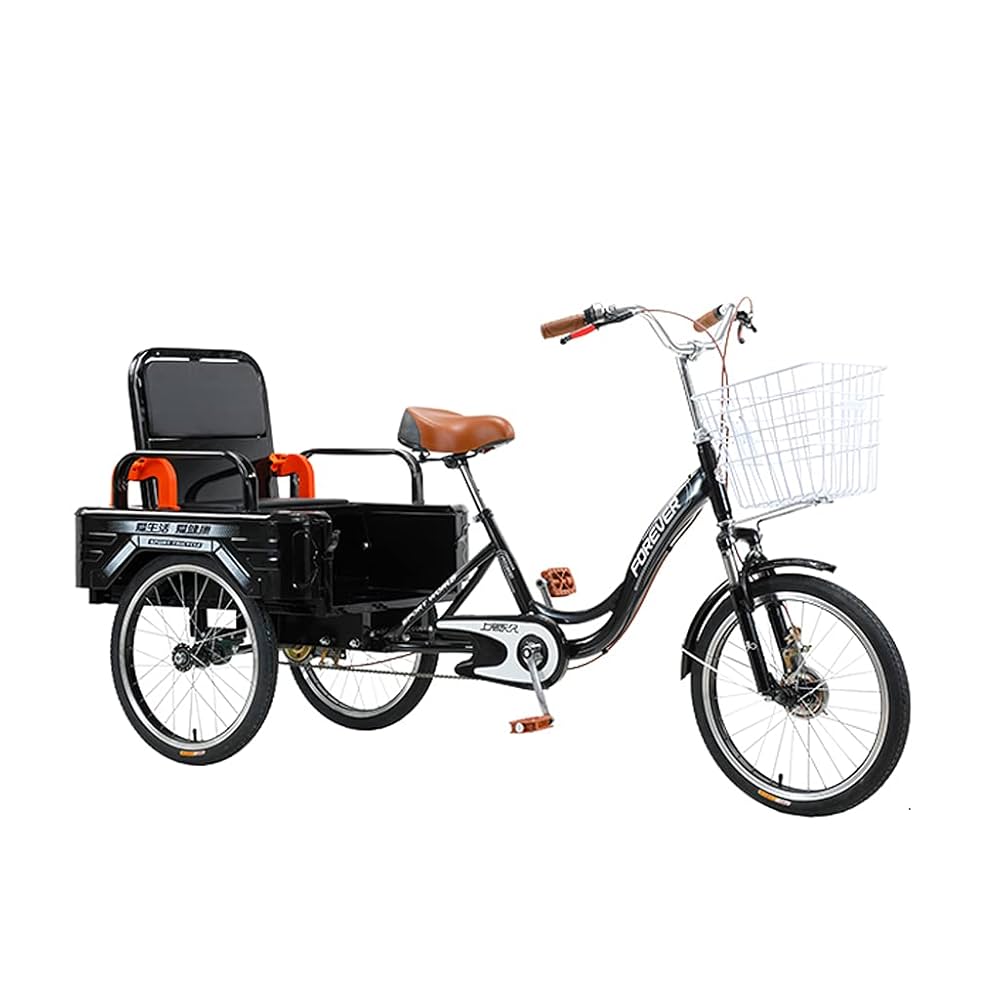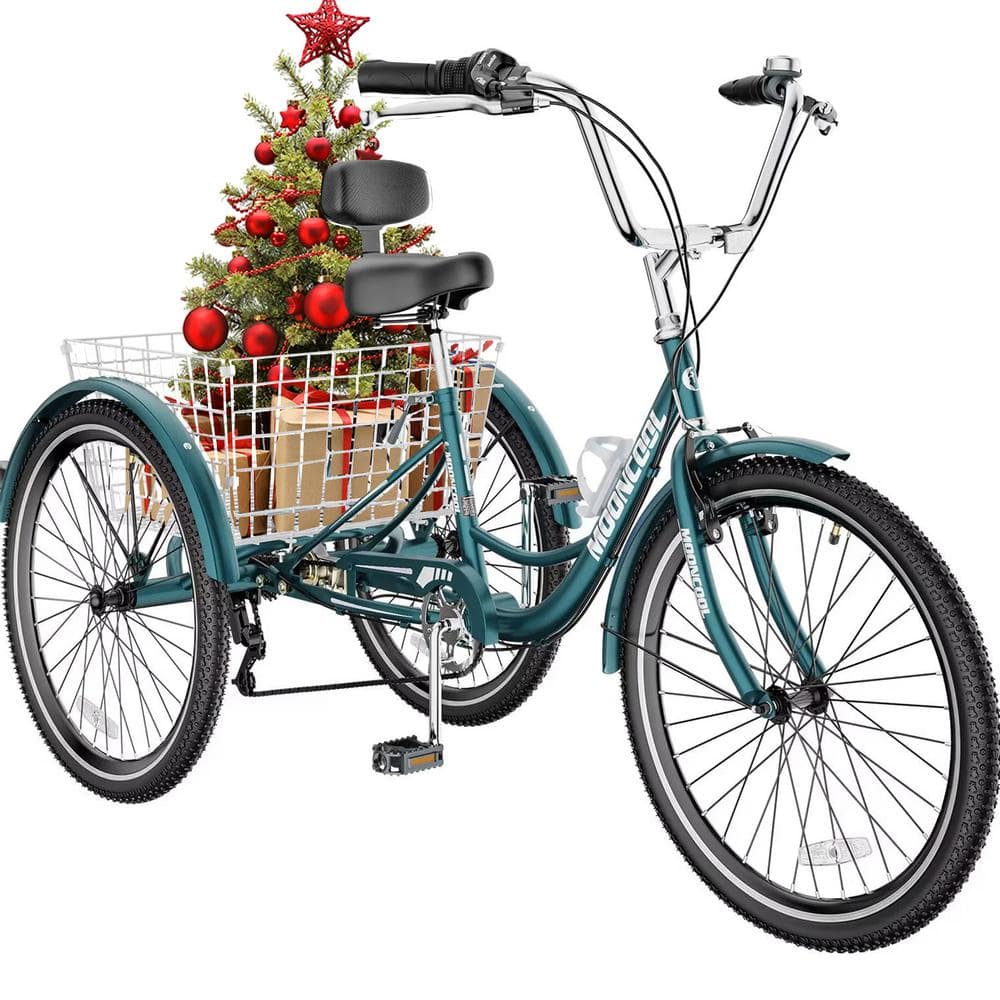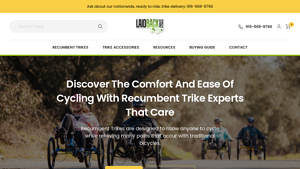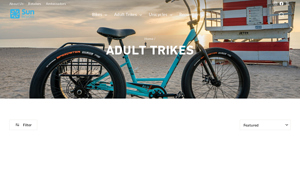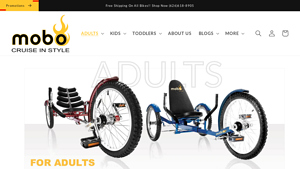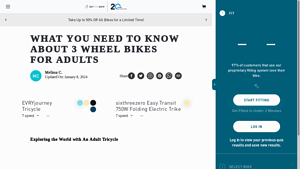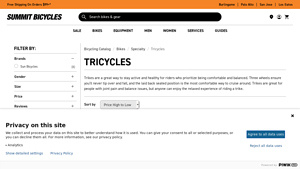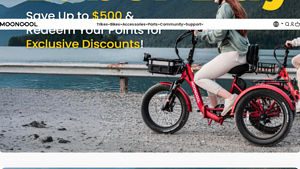Introduction: Navigating the Global Market for 3 wheel bicycle
Navigating the global market for three-wheel bicycles presents unique challenges for international B2B buyers, particularly those from regions like Africa, South America, the Middle East, and Europe. Sourcing high-quality, comfortable three-wheel bicycles that meet diverse consumer needs—whether for recreational use, mobility assistance, or commercial applications—can be daunting. This comprehensive guide aims to demystify the complexities of purchasing three-wheel bicycles, providing actionable insights into various types, their applications, and essential factors to consider when vetting suppliers.
As the demand for three-wheel bicycles continues to grow due to their stability and ease of use, understanding the market landscape is crucial for informed decision-making. From electric-assisted models that cater to urban commuters to recumbent trikes designed for enhanced comfort, this guide covers the spectrum of options available. It also delves into pricing structures, potential import regulations, and logistical considerations, ensuring that buyers are well-equipped to navigate the procurement process effectively.
By empowering B2B buyers with knowledge and strategic insights, this guide facilitates confident purchasing decisions that align with market demands and consumer preferences. Whether you are a distributor, retailer, or fleet manager, the information contained within will enable you to capitalize on the growing three-wheel bicycle market, ultimately leading to increased customer satisfaction and business success.
Understanding 3 wheel bicycle Types and Variations
| Type Name | Key Distinguishing Features | Primary B2B Applications | Brief Pros & Cons for Buyers |
|---|---|---|---|
| Recumbent Trikes | Ergonomic design, low center of gravity, comfortable seating | Mobility aids, recreational use | Pros: Excellent comfort, stability, and ease of use. Cons: Generally higher cost and limited cargo capacity. |
| Electric Trikes | Integrated electric motor for pedal assist | Delivery services, tourism | Pros: Reduced effort for longer distances, appeals to a wider customer base. Cons: Higher maintenance and initial investment. |
| Traditional Trikes | Standard upright seating, often with a cargo basket | Family transport, leisure riding | Pros: Familiar design, usually lower cost. Cons: Less stability and comfort compared to recumbent models. |
| Cargo Trikes | Enhanced storage capacity, often with larger frames | Delivery, logistics, and utilities | Pros: Increased cargo space, ideal for transporting goods. Cons: Heavier and may require more effort to maneuver. |
| Adaptive Trikes | Customizable for individuals with disabilities | Rehabilitation, specialized transport | Pros: Tailored for specific needs, enhances mobility for users. Cons: Can be expensive and require specialized knowledge for procurement. |
What Are the Characteristics of Recumbent Trikes and Their B2B Suitability?
Recumbent trikes are designed with an ergonomic seating position that promotes comfort and reduces strain on the back and joints. This makes them particularly suitable for individuals seeking a stable and comfortable ride, including seniors and those with mobility challenges. B2B buyers in sectors like healthcare and recreational services should consider these trikes for their ability to enhance user experience while providing a safe riding option. Key purchasing considerations include evaluating the frame materials, weight capacity, and comfort features to ensure they meet the needs of the end-users.
How Do Electric Trikes Enhance Business Operations?
Electric trikes are equipped with a pedal-assist feature that allows for easier navigation over longer distances or hilly terrains. This makes them ideal for businesses involved in delivery services or tourism, where efficiency and speed are crucial. When considering electric trikes, B2B buyers should analyze battery life, motor power, and overall maintenance costs. The initial investment may be higher, but the long-term benefits of reduced labor intensity and increased operational range can justify the expense.
What Are the Benefits of Traditional Trikes for Family Transport?
Traditional trikes feature a standard upright seating arrangement and often include a cargo basket, making them a practical choice for family transport and leisure riding. They appeal to buyers looking for affordable options for community programs or family-oriented businesses. While they are generally less expensive than recumbent or electric models, B2B buyers should be aware of their limitations in terms of stability and comfort, especially for older riders or those with balance issues.
Why Choose Cargo Trikes for Delivery and Logistics?
Cargo trikes are specifically designed to accommodate larger loads, making them ideal for businesses focused on delivery or logistics. Their enhanced storage capacity allows for the transport of goods while maintaining a compact footprint. B2B buyers should consider the trike’s weight limit, maneuverability, and ease of loading when selecting a model. While they provide excellent utility, buyers must also account for the increased weight and potential difficulty in navigating tight spaces.
How Do Adaptive Trikes Support Specialized Needs?
Adaptive trikes are customizable to meet the unique requirements of individuals with disabilities, making them essential for rehabilitation centers and specialized transport services. These trikes often feature adjustable seating and support systems tailored to the user’s needs. B2B buyers should focus on the adaptability of the trike, ease of access, and safety features when purchasing. Although they may come with a higher price tag, the value they provide in enhancing mobility for users with specific needs can be significant.
Key Industrial Applications of 3 wheel bicycle
| Industry/Sector | Specific Application of 3 Wheel Bicycle | Value/Benefit for the Business | Key Sourcing Considerations for this Application |
|---|---|---|---|
| Healthcare | Patient Transportation | Provides safe and comfortable transport for patients, especially seniors or those with mobility issues. | Consider durability, ease of use, and comfort features. |
| Logistics and Delivery | Urban Goods Transportation | Efficient for last-mile delivery in urban areas, reducing congestion and carbon footprint. | Evaluate load capacity, range (for electric models), and maintenance support. |
| Recreational Services | Leisure Rentals for Tourists | Attracts tourists seeking unique local experiences, enhancing business visibility and profitability. | Focus on design appeal, comfort, and ease of maintenance. |
| Community Programs | Mobility Solutions for Low-Income Areas | Offers affordable transportation options, promoting social inclusion and mobility for underserved populations. | Assess cost-effectiveness and suitability for diverse terrains. |
| Education | Campus Mobility Solutions | Facilitates easy transportation for students and staff, improving campus accessibility. | Look for models that are lightweight, maneuverable, and easy to store. |
How Are 3 Wheel Bicycles Used in Healthcare Settings?
In healthcare, 3 wheel bicycles serve as an effective means of patient transportation, particularly for individuals with mobility challenges. These tricycles provide a stable platform for safe transit, reducing the risk of falls compared to traditional bicycles. For international buyers, especially in regions like Africa and South America, sourcing models with ergonomic designs and additional comfort features is crucial, ensuring that they cater to the needs of elderly or disabled patients. Durability and ease of maintenance are also key considerations to ensure long-term use in varied environments.
What Are the Benefits of 3 Wheel Bicycles in Logistics and Delivery?
In the logistics sector, 3 wheel bicycles are increasingly utilized for urban goods transportation, particularly in densely populated areas. They provide an eco-friendly alternative to traditional delivery vehicles, effectively addressing issues related to traffic congestion and emissions. For businesses in Europe and the Middle East, it is essential to select models with sufficient load capacity and range, especially if considering electric tricycles. Moreover, understanding local regulations regarding vehicle types and weights can impact sourcing decisions.
How Can Recreational Services Leverage 3 Wheel Bicycles?
Recreational services can benefit from incorporating 3 wheel bicycles into their offerings, particularly for leisure rentals aimed at tourists. These tricycles provide a unique and enjoyable way for visitors to explore local attractions, thus enhancing customer experience and increasing revenue opportunities. When sourcing, businesses should prioritize visually appealing designs and user-friendly features to attract a diverse clientele. Additionally, ease of maintenance is critical to ensure operational efficiency and customer satisfaction.
In What Ways Do Community Programs Utilize 3 Wheel Bicycles?
Community programs, especially in low-income areas, leverage 3 wheel bicycles as a cost-effective mobility solution. These tricycles offer an affordable transportation option, promoting social inclusion and enhancing mobility for individuals who may lack access to traditional vehicles. For international buyers from regions like Africa, it is vital to consider models that are robust and suitable for various terrains, ensuring that they can withstand local conditions. Evaluating cost-effectiveness will help maximize the impact of community initiatives.
How Are 3 Wheel Bicycles Enhancing Campus Mobility?
In educational settings, 3 wheel bicycles facilitate campus mobility for students and staff, providing an efficient means of navigating larger university grounds. These bicycles can help reduce reliance on cars, promoting a greener campus environment. Buyers in Europe and the Middle East should look for lightweight models that are easy to maneuver and store, as well as those that offer comfort features to accommodate diverse users. Ensuring that the bicycles align with campus accessibility standards is also essential for broader adoption.
3 Common User Pain Points for ‘3 wheel bicycle’ & Their Solutions
Scenario 1: Stability Concerns for Senior Riders
The Problem: Many B2B buyers in the health and wellness sector are concerned about the stability of three-wheel bicycles, particularly when marketing them to seniors or individuals with mobility issues. Traditional bicycles can pose a risk of falls or accidents, which can deter potential customers. B2B buyers need to ensure that the products they offer provide a safe and comfortable riding experience to instill confidence in their clients.
The Solution: To address stability concerns, buyers should prioritize sourcing three-wheel bicycles designed specifically for enhanced balance. Look for models with a low center of gravity and a wide wheelbase, which significantly improve stability. Additionally, consider tricycles with features such as a low step-over height and a comfortable seat that offers back support, making it easier for seniors to mount and dismount safely. When selecting a supplier, inquire about the bike’s weight distribution and test ride several options to determine which models provide the best stability. Providing customers with detailed specifications and safety features can help alleviate their fears and encourage them to make a purchase.
Scenario 2: Comfort and Ergonomics for Extended Use
The Problem: B2B buyers often struggle with finding three-wheel bicycles that are comfortable for extended use, especially for customers who may have physical limitations or chronic conditions. Discomfort can lead to fatigue, making it less likely that individuals will use the bicycles regularly, ultimately affecting the buyer’s reputation and sales.
The Solution: Buyers should focus on sourcing three-wheel bicycles that offer ergonomic designs tailored for comfort during long rides. Look for features such as adjustable seating, cushioned seats, and handlebars that allow for a natural riding posture. Additionally, consider models that provide adjustable pedal positions and footrests, which can accommodate a wider range of body types and preferences. When discussing options with manufacturers, ask about the materials used in the construction of seats and grips, as well as any customization options available. Encouraging customers to take test rides can help them identify the most comfortable options, leading to higher satisfaction and increased usage rates.
Scenario 3: Maintenance and Support Challenges
The Problem: B2B buyers often encounter difficulties with the maintenance and support of three-wheel bicycles, especially in regions with limited access to specialized service providers. This can lead to customer dissatisfaction if bikes break down or require repairs that are not readily available. Buyers need solutions that ensure long-term usability and minimize the risk of service-related issues.
The Solution: To mitigate maintenance challenges, buyers should partner with suppliers that offer comprehensive after-sales support and easy access to spare parts. Select manufacturers known for their durability and reliability, and inquire about the availability of maintenance kits and instructional materials for basic repairs. Additionally, consider offering training sessions or workshops for customers to educate them on proper maintenance practices. This proactive approach not only empowers customers but also fosters a sense of community around the product. Furthermore, establishing a local network of service providers can enhance customer trust and make it easier for them to seek assistance when needed, ultimately increasing customer retention and satisfaction.
Strategic Material Selection Guide for 3 wheel bicycle
What are the Best Materials for Manufacturing 3 Wheel Bicycles?
When selecting materials for the construction of 3 wheel bicycles, several factors come into play, including performance, durability, cost, and regional compliance standards. Here, we analyze four common materials used in the manufacturing of 3 wheel bicycles, focusing on their properties, advantages, disadvantages, and implications for international buyers.
How Does Aluminum Benefit 3 Wheel Bicycle Construction?
Aluminum is a popular choice for bicycle frames due to its lightweight nature and resistance to corrosion. It typically has a temperature rating suitable for a wide range of climates, making it ideal for various international markets.
Pros: Aluminum is durable, offers excellent strength-to-weight ratio, and is relatively easy to manufacture. Its corrosion resistance ensures longevity, particularly in humid or coastal regions.
Cons: The primary drawback is its cost, which can be higher than steel. Additionally, aluminum may not absorb shocks as well as other materials, leading to a less comfortable ride on uneven surfaces.
Impact on Application: Aluminum is compatible with various media, including moisture and UV exposure, making it suitable for diverse environments.
International Considerations: Buyers from regions like Africa and South America should ensure that the aluminum used complies with local standards (e.g., ASTM or ISO). In markets like Europe, adherence to EU regulations regarding material safety is essential.
What Role Does Steel Play in 3 Wheel Bicycle Manufacturing?
Steel is another common material used in the construction of 3 wheel bicycles, particularly for frames and components that require high strength and durability.
Pros: Steel is known for its toughness and ability to withstand high stress. It is also generally more affordable than aluminum, making it an attractive option for budget-conscious buyers.
Cons: The main disadvantage of steel is its susceptibility to rust and corrosion if not properly treated. Additionally, steel frames tend to be heavier, which can affect performance.
Impact on Application: Steel’s high tensile strength makes it suitable for heavy-duty applications, but it requires protective coatings to ensure longevity in harsh environments.
International Considerations: Compliance with standards such as JIS in Japan or DIN in Germany is crucial for international buyers. Buyers in the Middle East should also consider the impact of high temperatures on steel components.
How Does Carbon Fiber Enhance 3 Wheel Bicycle Performance?
Carbon fiber is increasingly being utilized in high-end 3 wheel bicycles due to its superior strength-to-weight ratio and stiffness.
Pros: Carbon fiber frames are incredibly lightweight and can be molded into aerodynamic shapes, enhancing performance. They also provide excellent vibration damping, leading to a smoother ride.
Cons: The primary limitation of carbon fiber is its cost, which is significantly higher than both aluminum and steel. Additionally, carbon fiber can be more challenging to repair if damaged.
Impact on Application: Carbon fiber is compatible with various environmental conditions but can be susceptible to UV damage if not properly coated.
International Considerations: Buyers should ensure that carbon fiber products meet international safety standards and consider the logistics of sourcing and shipping this material, especially in regions with less access to advanced manufacturing technologies.
What Advantages Does Titanium Offer for 3 Wheel Bicycles?
Titanium is a premium material known for its strength, lightweight properties, and corrosion resistance.
Pros: Titanium offers exceptional durability and is resistant to rust and corrosion, making it ideal for long-term use in various climates. It also provides a comfortable ride due to its natural shock-absorbing qualities.
Cons: The major downside is the high cost of titanium, which can be prohibitive for many manufacturers. Additionally, the complexity of the manufacturing process can lead to longer production times.
Impact on Application: Titanium is suitable for all environmental conditions and can withstand extreme temperatures and pressures, making it an excellent choice for high-performance applications.
International Considerations: Buyers should be aware of specific compliance requirements in their regions, particularly in Europe, where stringent regulations may apply to premium materials.
Summary Table of Material Selection for 3 Wheel Bicycles
| Material | Typical Use Case for 3 Wheel Bicycle | Key Advantage | Key Disadvantage/Limitation | Relative Cost (Low/Med/High) |
|---|---|---|---|---|
| Aluminum | Frame and components | Lightweight and corrosion-resistant | Higher cost than steel | Medium |
| Steel | Frame and heavy-duty components | Tough and cost-effective | Susceptible to rust | Low |
| Carbon Fiber | High-performance frames | Superior strength-to-weight ratio | High cost and difficult to repair | High |
| Titanium | Premium frames | Exceptional durability and comfort | Very high cost and complex to manufacture | High |
This strategic material selection guide aims to assist international B2B buyers in making informed decisions when sourcing materials for 3 wheel bicycles, ensuring compliance with regional standards and optimizing product performance.
In-depth Look: Manufacturing Processes and Quality Assurance for 3 wheel bicycle
What Are the Key Stages in the Manufacturing Process of 3-Wheel Bicycles?
The manufacturing process of 3-wheel bicycles involves several critical stages, each contributing to the overall quality and functionality of the final product. Understanding these stages helps B2B buyers assess the capabilities of potential suppliers.
Material Preparation: What Materials Are Used and Why?
The first stage in the manufacturing process is material preparation. Manufacturers typically use high-quality steel, aluminum, or even carbon fiber for the frame, depending on the desired weight, strength, and cost.
- Steel is favored for its durability and cost-effectiveness, making it a common choice for budget-friendly models.
- Aluminum offers a lightweight alternative, beneficial for electric-assisted models where weight savings can enhance performance.
- Carbon fiber is utilized in high-end models for its superior strength-to-weight ratio, although it comes at a higher price point.
Once the materials are selected, they undergo cutting, bending, and shaping to prepare them for the next phase.
Forming: How Are Components Shaped and Assembled?
The forming process involves various techniques to shape the components of the bicycle. Common methods include:
- Welding: This is a crucial technique for joining frame components. High-frequency welding is often employed to ensure strong, durable joints.
- Molding: For plastic parts, such as fenders and seat backs, injection molding is used to achieve precise shapes and finishes.
- Machining: Critical components such as hubs and cranksets are often machined to ensure high tolerances and performance.
Each of these techniques requires skilled labor and specialized machinery, which can vary significantly across manufacturers.
Assembly: What Are the Steps in Assembling a 3-Wheel Bicycle?
Once the components are formed, the assembly process begins. This stage involves:
- Frame Assembly: The primary structure is assembled first, including attaching the front and rear wheels to the frame.
- Component Integration: Essential components like brakes, gears, and electrical systems (for e-trikes) are integrated into the frame.
- Final Adjustments: After the main assembly, fine adjustments are made to ensure everything is aligned correctly and operates smoothly.
Quality control checks should be implemented at every step to ensure that the assembly meets the required specifications.
Finishing: What Techniques Are Used for Surface Treatment?
The finishing stage enhances the bicycle’s aesthetic appeal and protects it from environmental factors. Techniques include:
- Painting: A powder coating or liquid paint is applied to the frame, providing both color and protection against corrosion.
- Anodizing: For aluminum parts, anodizing can be used to increase resistance to wear and corrosion while enhancing visual appeal.
Proper finishing not only improves the bicycle’s look but also extends its lifespan, which is crucial for B2B buyers looking for durability.
What Quality Assurance Practices Should B2B Buyers Expect?
Quality assurance (QA) is a vital part of the manufacturing process, ensuring that products meet both international and industry-specific standards. For B2B buyers, understanding these QA practices is essential for evaluating suppliers.
Which International Standards Should Manufacturers Comply With?
Many manufacturers adhere to international standards such as ISO 9001, which focuses on quality management systems. Compliance with ISO standards ensures that manufacturers have established processes for quality control, enhancing reliability for buyers.
Additionally, industry-specific certifications, such as CE marking in Europe and API standards in certain markets, ensure that products meet specific safety and performance requirements.
What Are the Key Quality Control Checkpoints?
Quality control is typically divided into three main checkpoints:
- Incoming Quality Control (IQC): This involves inspecting raw materials upon arrival to ensure they meet specifications before production begins.
- In-Process Quality Control (IPQC): Ongoing inspections during the manufacturing process help catch any defects early, reducing waste and rework.
- Final Quality Control (FQC): The final inspection involves thorough testing of the assembled bicycles to ensure they meet all specifications and standards.
These checkpoints are crucial for maintaining consistent quality throughout the production process.
What Common Testing Methods Are Used in Quality Assurance?
Manufacturers employ various testing methods, including:
- Functional Testing: Ensuring that all mechanical and electrical components work correctly.
- Stress Testing: Subjecting the bicycles to conditions beyond normal use to evaluate durability and performance.
- Safety Testing: Checking for compliance with safety standards, particularly for components like brakes and electrical systems.
Documentation of these tests is essential for transparency and traceability.
How Can B2B Buyers Verify Supplier Quality Control?
For international buyers, particularly those in Africa, South America, the Middle East, and Europe, verifying a supplier’s quality control processes is vital.
What Steps Can Buyers Take to Verify Supplier Quality?
- Conduct Audits: Regular audits of suppliers can provide insights into their manufacturing processes and adherence to quality standards.
- Request Quality Reports: Buyers should request documentation of quality control processes and testing results to assess compliance.
- Engage Third-Party Inspectors: Utilizing third-party inspection services can provide an unbiased evaluation of the supplier’s quality control measures.
These steps help mitigate risks associated with international sourcing and ensure that the products meet the buyer’s quality expectations.
What Are the Specific QC Considerations for International Buyers?
When sourcing from international suppliers, B2B buyers should consider:
- Cultural Differences: Understanding local practices can affect quality expectations and communication.
- Logistics and Shipping: Ensure that quality control measures extend to packaging and shipping to prevent damage during transit.
- Regulatory Compliance: Familiarity with local regulations can help ensure that products meet necessary legal requirements in the buyer’s market.
By focusing on these aspects, international buyers can enhance their sourcing strategy, ensuring they partner with reliable manufacturers who prioritize quality.
Practical Sourcing Guide: A Step-by-Step Checklist for ‘3 wheel bicycle’
Introduction
This practical sourcing guide aims to assist B2B buyers in effectively procuring three-wheel bicycles, also known as tricycles. Whether you are looking to serve a specific market or enhance your product offerings, this checklist provides essential steps to ensure a successful procurement process.
Step 1: Define Your Target Market and Purpose
Understanding your target market is crucial for making informed purchasing decisions. Identify whether you are catering to recreational users, seniors, or commercial entities needing utility bikes. Each segment may have different preferences regarding features such as comfort, design, and pricing.
- Market Needs: Research regional preferences, especially in areas like Africa, South America, and the Middle East, where market demands may differ significantly.
- Usage Scenarios: Consider if the tricycles will be used for leisure, transportation, or specialized applications like delivery services.
Step 2: Determine Technical Specifications
Establish the technical specifications for the tricycles you intend to procure. This includes aspects like weight capacity, wheel size, and type of assistance (manual vs. electric).
- Performance Features: Look for tricycles with features that enhance stability and comfort, such as low centers of gravity and ergonomic seating.
- Durability Requirements: Evaluate the materials used in construction to ensure they can withstand the conditions in your target market.
Step 3: Research Potential Suppliers
Conduct thorough research to identify reliable suppliers who specialize in three-wheel bicycles. This step is vital to ensure product quality and supplier reliability.
- Supplier Background: Investigate their history, production capacity, and market reputation through customer reviews and case studies.
- Product Range: Ensure the supplier offers a diverse range of models that meet your defined specifications.
Step 4: Request Samples for Evaluation
Before finalizing a supplier, request samples of their tricycles for hands-on evaluation. This step allows you to assess the quality, comfort, and usability directly.
- Testing Conditions: Evaluate the samples under realistic conditions to understand how they perform.
- User Feedback: If possible, involve potential users in the testing process to gather their feedback on comfort and functionality.
Step 5: Verify Compliance and Certifications
It’s essential to verify that the tricycles meet relevant safety and quality standards. Compliance with international regulations ensures that your products are safe and market-ready.
- Documentation: Request certificates of compliance and quality assurance from the supplier.
- Standards Adherence: Confirm adherence to regional regulations, particularly in markets with stringent safety requirements.
Step 6: Negotiate Terms and Conditions
Once you have selected a supplier, negotiate favorable terms and conditions to protect your interests. This includes price, payment terms, and delivery timelines.
- Volume Discounts: Discuss potential discounts for bulk purchases, which can significantly impact your cost structure.
- After-Sales Support: Ensure that the supplier provides adequate after-sales support, including warranty policies and maintenance services.
Step 7: Establish a Logistics Plan
Develop a logistics plan for the delivery and distribution of the tricycles. This plan should account for shipping methods, lead times, and storage solutions.
- Transport Considerations: Choose reliable shipping partners who can handle the transportation of large quantities efficiently.
- Inventory Management: Plan for adequate storage solutions to manage inventory effectively once the tricycles arrive.
By following this checklist, B2B buyers can streamline their procurement process for three-wheel bicycles, ensuring they meet the needs of their target market while securing quality products from reliable suppliers.
Comprehensive Cost and Pricing Analysis for 3 wheel bicycle Sourcing
What Are the Key Cost Components in Sourcing 3 Wheel Bicycles?
When analyzing the cost structure for sourcing 3 wheel bicycles, several key components must be considered:
-
Materials: The choice of materials significantly affects the cost. High-quality aluminum or steel frames, durable tires, and reliable braking systems contribute to higher initial costs but can enhance longevity and customer satisfaction.
-
Labor: Labor costs can vary widely depending on the location of manufacturing. Countries with lower labor costs may offer more competitive pricing, but this can sometimes compromise quality. Skilled labor is necessary for precise assembly, especially for customized models.
-
Manufacturing Overhead: This includes costs related to production facilities, utilities, and administrative expenses. Efficient production processes can reduce overhead, allowing for more competitive pricing.
-
Tooling: The initial investment in tooling and machinery for production can be substantial. This cost is typically amortized over a larger production volume, meaning that higher order quantities can lead to lower per-unit costs.
-
Quality Control (QC): Implementing stringent QC measures is essential to ensure product reliability and safety. While this may increase costs, it can prevent costly recalls and enhance brand reputation.
-
Logistics: Shipping costs are influenced by distance, mode of transport, and packaging. Companies must choose between air freight for speed or sea freight for cost-efficiency, especially when exporting to regions like Africa or South America.
-
Margin: Suppliers typically add a markup to cover their costs and ensure profitability. Understanding the typical margins in the industry can aid buyers in assessing fair pricing.
How Do Price Influencers Impact the Cost of 3 Wheel Bicycles?
Various factors can influence pricing in the B2B market for 3 wheel bicycles:
-
Volume/MOQ (Minimum Order Quantity): Ordering in bulk can lead to significant discounts. Suppliers often have tiered pricing structures that reward larger orders with lower per-unit costs.
-
Specifications and Customization: Customized features—such as electric assist options, color variations, or specialized accessories—can increase costs. Buyers should weigh the benefits of customization against the additional expense.
-
Materials and Quality Certifications: Higher quality materials and certifications (e.g., ISO, CE) can increase production costs but may result in a more durable product. For international buyers, ensuring compliance with local regulations can also impact pricing.
-
Supplier Factors: The reputation, reliability, and service level of the supplier can influence pricing. Established suppliers may charge a premium for their expertise and customer service.
-
Incoterms: These terms define the responsibilities of buyers and sellers regarding shipping costs, insurance, and customs clearance. Understanding these terms can help buyers avoid unexpected expenses.
What Tips Can Help Buyers Negotiate Better Prices for 3 Wheel Bicycles?
-
Negotiate Based on Volume: Leverage larger order quantities to negotiate better prices. Discuss potential future orders to build a long-term partnership with suppliers.
-
Consider Total Cost of Ownership (TCO): Evaluate the long-term costs associated with the bicycles, including maintenance, repair, and potential resale value. A higher upfront cost may be justified if the product offers lower TCO over time.
-
Research and Compare Prices: Conduct market research to understand the pricing landscape. This knowledge can empower buyers during negotiations and help identify competitive offers.
-
Be Aware of Pricing Nuances for International Transactions: Understand the implications of currency fluctuations, tariffs, and local taxes when importing bicycles from different regions. These factors can significantly affect the final cost.
-
Establish Clear Communication: Ensure clear communication with suppliers regarding expectations, specifications, and delivery timelines. This transparency can foster trust and lead to better pricing arrangements.
In conclusion, a comprehensive understanding of the cost components, price influencers, and negotiation strategies is crucial for B2B buyers in the 3 wheel bicycle market. As pricing can vary based on numerous factors, diligent research and strategic planning will facilitate more effective sourcing decisions.
Disclaimer: Prices provided in this analysis are indicative and subject to change based on market conditions and supplier negotiations.
Alternatives Analysis: Comparing 3 wheel bicycle With Other Solutions
Understanding Alternatives to the 3 Wheel Bicycle
When considering the purchase of a 3 wheel bicycle, it’s essential to evaluate alternative solutions that can meet similar needs for stability, comfort, and functionality. This comparative analysis focuses on two viable alternatives: electric scooters and traditional bicycles. Each option has its own set of advantages and drawbacks, making it crucial for B2B buyers to assess their unique requirements before making a decision.
Comparison Table
| Comparison Aspect | 3 Wheel Bicycle | Electric Scooter | Traditional Bicycle |
|---|---|---|---|
| Performance | High stability; suitable for all terrain | Moderate speed; ideal for urban commuting | High speed; versatile for various terrains |
| Cost | $600 – $6,650+ | $300 – $1,500+ | $300 – $3,000+ |
| Ease of Implementation | Requires assembly; easy to ride | Minimal setup; intuitive controls | Generally easy to ride; may require adjustments |
| Maintenance | Moderate; tires and brakes need regular checks | Low; battery maintenance needed | Moderate; regular tune-ups required |
| Best Use Case | Recreational use, fitness, and transport for seniors | Urban commuting and short-distance travel | Versatile for commuting, recreation, and fitness |
In-Depth Analysis of Alternatives
Electric Scooters
Electric scooters are a growing alternative for urban transportation, offering a compact design and ease of use. They typically have a maximum speed of around 15-20 mph, making them suitable for commuting in city environments. The cost of electric scooters varies widely, depending on battery capacity and features, but they are generally more affordable than high-end 3 wheel bicycles. However, they may lack the stability that a 3 wheel bicycle provides, especially for users with balance issues. Maintenance is minimal, primarily focusing on battery care, but the need for charging can be a drawback for longer distances.
Traditional Bicycles
Traditional bicycles remain a popular choice for many riders due to their versatility and performance across different terrains. They can be used for commuting, fitness, or leisure riding, offering a more dynamic riding experience compared to 3 wheel bicycles. The price range is broad, allowing buyers to choose based on their budget and intended use. However, traditional bicycles can be challenging for individuals with balance concerns or physical limitations, making them less accessible for some demographics. Maintenance requirements are moderate, with regular tune-ups needed to keep them in optimal condition.
Making the Right Choice for Your Needs
When choosing between a 3 wheel bicycle and its alternatives, B2B buyers should consider factors such as the intended use, budget, and user demographics. For organizations focusing on accessibility and comfort, especially for seniors or those with mobility challenges, the 3 wheel bicycle is likely the best fit. On the other hand, if the goal is to promote urban commuting among younger demographics, electric scooters may be more appealing. Traditional bicycles offer a balance of performance and versatility, catering to a broader audience. Ultimately, understanding the specific needs of your target market will guide you in selecting the most suitable solution.
Essential Technical Properties and Trade Terminology for 3 wheel bicycle
What Are the Key Technical Properties of a 3 Wheel Bicycle?
Understanding the essential technical specifications of a three-wheel bicycle is crucial for B2B buyers. These properties directly impact performance, safety, and user satisfaction. Here are some critical specifications to consider:
1. Material Grade
The frame material significantly influences the durability and weight of the tricycle. Common materials include aluminum, steel, and carbon fiber. Aluminum is lightweight and resistant to corrosion, making it ideal for urban environments. Steel offers robustness but adds weight, while carbon fiber provides a high strength-to-weight ratio for premium models. Choosing the right material can affect shipping costs, maintenance, and overall lifecycle of the product.
2. Weight Capacity
Each three-wheel bicycle comes with a specified weight limit that dictates its usability. This specification is crucial for B2B buyers targeting specific demographics, such as seniors or individuals with mobility challenges. Understanding weight capacity helps ensure that the product meets customer needs without compromising safety or performance.
3. Wheel Size
The size of the wheels affects stability and maneuverability. Common sizes range from 16 to 26 inches. Larger wheels generally provide better rolling efficiency over uneven surfaces, making them suitable for varied terrains. Conversely, smaller wheels may offer improved agility, particularly in urban settings. Buyers should consider the intended use when evaluating wheel size.
4. Gearing System
The gearing system influences the tricycle’s performance, especially in hilly or varied terrains. Common types include single-speed and multi-speed systems. A multi-speed system allows for easier pedaling on inclines, enhancing user experience and accessibility. B2B buyers should assess their target market’s cycling conditions to select the appropriate gearing system.
5. Braking System
Safety is paramount in any cycling product. Most three-wheel bicycles utilize either drum brakes or disc brakes. Drum brakes are often more reliable in wet conditions, while disc brakes provide superior stopping power. Understanding the braking mechanism is essential for B2B buyers focusing on safety standards and customer satisfaction.
6. Adjustability Features
Adjustability in seat height and handlebar position can significantly enhance user comfort and accessibility. Many models offer adjustable components to accommodate a wider range of body types. This feature is particularly appealing in markets that prioritize comfort and usability, such as those catering to seniors or people with disabilities.
What Are Common Trade Terms in the 3 Wheel Bicycle Industry?
Familiarity with industry terminology is essential for effective communication and negotiation in B2B transactions. Here are several key terms that are frequently encountered in the three-wheel bicycle market:
1. OEM (Original Equipment Manufacturer)
OEM refers to companies that produce parts and equipment that may be marketed by another manufacturer. Understanding the OEM landscape can help B2B buyers identify reliable suppliers and ensure product quality. This is particularly relevant when sourcing components for custom builds or replacements.
2. MOQ (Minimum Order Quantity)
MOQ denotes the smallest quantity of product that a supplier is willing to sell. This term is critical for B2B buyers to understand their purchasing power and negotiate terms that align with their inventory and cash flow needs.
3. RFQ (Request for Quotation)
An RFQ is a document that a buyer sends to suppliers to request pricing information for specific products. This process is essential for obtaining competitive pricing and ensuring that all potential suppliers are evaluated fairly.
4. Incoterms (International Commercial Terms)
Incoterms define the responsibilities of buyers and sellers in international trade. They clarify who is responsible for shipping, insurance, and tariffs. Familiarity with these terms is crucial for B2B transactions, especially for companies importing or exporting three-wheel bicycles.
5. Lead Time
Lead time refers to the duration between placing an order and receiving the goods. Understanding lead times is critical for inventory management and ensuring that products are available to meet customer demand.
6. Warranty
A warranty is a guarantee provided by the manufacturer regarding the condition of the product. Knowing the warranty terms can inform buyers about the quality and reliability of the three-wheel bicycles they intend to purchase.
By understanding these technical properties and trade terminologies, B2B buyers can make informed decisions that enhance their offerings in the three-wheel bicycle market.
Navigating Market Dynamics and Sourcing Trends in the 3 wheel bicycle Sector
What Are the Key Trends Shaping the Global 3 Wheel Bicycle Market?
The global market for 3 wheel bicycles is witnessing significant growth, driven by a surge in demand for alternative modes of transport and recreational activities that cater to various demographics, including seniors and individuals with mobility challenges. Emerging technologies such as electric assist systems are enhancing the appeal of tricycles, making them more accessible and enjoyable for riders. Furthermore, the rising awareness of health and wellness among consumers is prompting an increase in leisure cycling, which is bolstered by the social distancing measures observed during the COVID-19 pandemic.
International B2B buyers, especially from regions like Africa, South America, the Middle East, and Europe, are increasingly drawn to these innovations. They are seeking suppliers who can provide reliable, high-quality products that meet the growing demand for comfort, safety, and performance. Additionally, the shift towards online purchasing platforms and direct-to-consumer sales is reshaping sourcing strategies, allowing buyers to access a broader range of products and negotiate better prices. B2B partnerships are also evolving, with companies looking for collaborative ventures that can offer customized solutions tailored to specific market needs.
How Does Sustainability Impact Sourcing in the 3 Wheel Bicycle Sector?
Sustainability has become a central theme in the sourcing strategies of international B2B buyers in the 3 wheel bicycle sector. The environmental impact of production processes and materials used in manufacturing bicycles is under scrutiny, prompting businesses to prioritize ethical sourcing practices. Buyers are increasingly seeking suppliers who demonstrate a commitment to reducing their carbon footprint, utilizing recycled materials, and adhering to sustainable manufacturing processes.
Incorporating ‘green’ certifications into product offerings can enhance a supplier’s credibility and attract environmentally-conscious buyers. Certifications such as ISO 14001 for environmental management and materials that are certified as sustainable can significantly influence purchasing decisions. By fostering ethical supply chains, businesses not only comply with regulatory standards but also appeal to a growing segment of consumers who value sustainability. This shift towards responsible sourcing is expected to play a crucial role in shaping market dynamics and competitive strategies in the 3 wheel bicycle sector.
What Is the Historical Context of 3 Wheel Bicycles in B2B Markets?
The history of 3 wheel bicycles can be traced back to the late 19th century, when they were primarily used for transportation and recreation. Over the decades, advancements in design and technology have transformed these vehicles into versatile options for a variety of users, including adults and seniors seeking comfort and stability. The introduction of recumbent designs and electric assist options has further expanded their appeal, allowing for a more enjoyable riding experience.
In recent years, the market has evolved to address specific user needs, leading to the development of specialized tricycles that cater to different demographics. This evolution reflects a broader trend in the cycling industry towards inclusivity and innovation, making the 3 wheel bicycle a viable option for B2B buyers looking to diversify their product offerings and meet the demands of a changing consumer landscape.
Frequently Asked Questions (FAQs) for B2B Buyers of 3 wheel bicycle
-
How do I choose the right 3-wheel bicycle for my business needs?
Selecting the right 3-wheel bicycle involves assessing your target market’s specific requirements. Consider factors such as the intended use (e.g., delivery, leisure, or mobility assistance), the terrain where they will be used, and the demographics of your customer base. Additionally, evaluate the comfort, stability, and weight capacity of different models. Engage with suppliers to understand customization options that can meet your market’s unique demands, and request sample units for evaluation before committing to larger orders. -
What are the key features to look for in a quality 3-wheel bicycle?
When sourcing 3-wheel bicycles, prioritize features such as frame material (aluminum or steel for durability), wheel size (larger wheels offer better stability), and ergonomic design for user comfort. Electric assist options can enhance the appeal for various demographics, especially in regions with varied terrain. Additionally, look for safety features like reflectors, lights, and reliable braking systems. Supplier transparency regarding product specifications and certifications is crucial for ensuring quality. -
What are the typical minimum order quantities (MOQ) for 3-wheel bicycles?
Minimum order quantities can vary significantly between suppliers. Generally, MOQs for 3-wheel bicycles range from 10 to 100 units, depending on the manufacturer and customization requirements. It’s advisable to discuss your purchasing plans with potential suppliers to negotiate favorable terms that align with your business model. Consider starting with a smaller order for testing the market before scaling up your purchases. -
How can I ensure the quality of the 3-wheel bicycles I purchase?
To ensure quality, perform thorough supplier vetting by checking their manufacturing processes, certifications, and customer reviews. Request samples before placing bulk orders, and consider implementing quality assurance (QA) inspections during production and before shipment. Additionally, establish clear agreements with suppliers regarding quality standards and warranties. Building a relationship with reliable manufacturers can lead to better quality control over time. -
What payment terms should I negotiate when sourcing 3-wheel bicycles?
Payment terms can vary, but common arrangements include a 30% deposit upon order confirmation and the remaining balance before shipment. Some suppliers may offer net 30 or net 60 payment terms, allowing time to generate revenue before settling the invoice. It’s crucial to negotiate terms that align with your cash flow needs while ensuring the supplier feels secure in the transaction. Always review payment options, including letters of credit or escrow services, to protect both parties. -
What shipping options are available for international orders of 3-wheel bicycles?
International shipping options typically include air freight for faster delivery and sea freight for cost-effective bulk shipments. Evaluate the urgency of your order and budget constraints when choosing a shipping method. Additionally, confirm the supplier’s ability to handle export documentation and customs clearance. Consider working with logistics partners who specialize in international trade to navigate the complexities of shipping to your target markets in Africa, South America, the Middle East, or Europe. -
How do I handle customs and import regulations when purchasing 3-wheel bicycles?
Understanding customs regulations is essential for smooth importation. Research the specific import duties and taxes applicable in your country, as well as any certifications required for bicycles. Collaborate with your supplier to ensure all necessary documentation, such as invoices, packing lists, and certificates of origin, are in order. Engaging a customs broker can also streamline the process, ensuring compliance and minimizing delays at customs. -
What are the benefits of offering customized 3-wheel bicycles to my customers?
Customizing 3-wheel bicycles can significantly enhance your product’s appeal, allowing you to cater to niche markets or specific customer preferences. Custom features may include color options, accessories like baskets or lights, and ergonomic adjustments for comfort. This level of personalization can differentiate your offerings from competitors, increase customer satisfaction, and potentially justify higher price points. Consider market research to identify popular customization options that resonate with your target audience.
Important Disclaimer & Terms of Use
⚠️ Important Disclaimer
The information provided in this guide, including content regarding manufacturers, technical specifications, and market analysis, is for informational and educational purposes only. It does not constitute professional procurement advice, financial advice, or legal advice.
While we have made every effort to ensure the accuracy and timeliness of the information, we are not responsible for any errors, omissions, or outdated information. Market conditions, company details, and technical standards are subject to change.
B2B buyers must conduct their own independent and thorough due diligence before making any purchasing decisions. This includes contacting suppliers directly, verifying certifications, requesting samples, and seeking professional consultation. The risk of relying on any information in this guide is borne solely by the reader.
Top 6 3 Wheel Bicycle Manufacturers & Suppliers List
1. Laid Back Cycles – Recumbent Trikes
Domain: laidbackcycles.com
Registered: 2011 (14 years)
Introduction: Recumbent Trikes at Laid Back Cycles include a variety of models such as ICE Adventure (Customizable) priced at $4,800.00, TerraTrike E.V.O. at $4,950.00 (regular price $5,100.00), Catrike eCAT Villager at $6,650.00, TerraTrike Charge at $3,450.00, TerraTrike Rambler at $2,450.00, and Catrike MAX at $3,650.00. Additional products include SportCrafters Roller – Trike Trainer for $234.99, Recumbent …
2. Sun Bike – E350-B1 Electric Trike
Domain: sun.bike
Introduction: {“products”:[{“name”:”E350-B1 Electric Trike”,”price”:”$2,599.99″,”color”:”Blue”,”status”:”Sold Out”},{“name”:”Miami Sun Traditional 24″,”price”:”$649.99″,”colors”:[“Red”,”Blue”,”Black”,”Purple”,”Green”,”Yellow”],”status”:”Sold Out”},{“name”:”Miami Sun Traditional 20″,”price”:”$649.99″,”colors”:[“Blue”,”Red”],”status”:”Sold Out”},{“name”:”Atlas Transit”,”price”:”$849.99″,”colors”:[“Black”,”Yellow”…
3. Mobo – Mobo Triton Pro
Domain: mobocruiser.com
Registered: 2009 (16 years)
Introduction: {“products”:[{“name”:”Mobo Triton Pro”,”type”:”Adult Recumbent Tricycle”,”regular_price”:”$699.99 USD”,”sale_price”:”$699.99 USD”,”unit_price”:”per”,”features”:{“gearing”:”Single Speed (Free Wheel)”,”wheel_size”:”20\” Front, 16\” Back”,”product_weight”:”44 lbs.”,”seat_height”:”12.5\””,”weight_capacity”:”250 lbs.”,”length_adjustment”:”10 Slot Adjustments in 16\” Length”,”height_capacity”:”4′ to 6′ …
4. Sixthreezero – 3-Wheel Bikes
Domain: sixthreezero.com
Registered: 2005 (20 years)
Introduction: 3-wheel bikes, also known as trikes or tricycles, are gaining popularity among adults for their comfort and convenience. They provide stability, making them suitable for busy adults, seniors, individuals with injuries or balance challenges, and families. These bikes often feature a rear basket for transporting goods. The market for adult tricycles is expanding, with a reported increase in U.S. bic…
5. Sun Bicycles – Baja Trike
Domain: summitbicycles.com
Registered: 1997 (28 years)
Introduction: Trikes For Sale – Summit Bicycles
1. **Sun Bicycles Baja Trike – 2019**
– Price: $1,299.99
– Features:
– High-tensile steel easy step-through frame
– 7-speed SunRace gearing
– Front and rear disc brakes with parking locks
– Alloy extra-wide rims with stainless steel spokes
– 24 x 3.50″ Sand Storm street tires
– High rise steel handlebar
– Deluxe saddle wit…
6. Mooncool – TK1 Folding Electric Trike
Domain: mooncool.com
Registered: 2013 (12 years)
Introduction: Mooncool Electric Trike: Tricycle for Adults, Seniors. Key Products: TK1 Folding Electric Trike – Commuter, for riders 5′-6’3″, Payload 450 lb, Power 500W, Range 70 miles, Top Speed 16 mph, Sale Price $1,499.99. TK Pro Electric Trike – Versatile, for riders 5′-6’3″, Payload 450 lb, Power 750W, Range 75 miles, Top Speed 16 mph, Sale Price $2,099.99. TK1 Fat Tire Electric Trike – 4″ Tire, for riders…
Strategic Sourcing Conclusion and Outlook for 3 wheel bicycle
In the rapidly evolving market for three-wheel bicycles, strategic sourcing emerges as a crucial element for international B2B buyers. By prioritizing quality, comfort, and innovative features—such as electric assist and ergonomic designs—companies can meet the diverse needs of consumers in regions like Africa, South America, the Middle East, and Europe. The demand for adult tricycles is being driven by an increasing focus on health, mobility, and accessibility, making it essential for buyers to align with reliable manufacturers that offer competitive pricing and robust after-sales support.
As you navigate the sourcing landscape, consider not only the product specifications but also the sustainability practices of your suppliers, as consumers are increasingly valuing eco-friendly options. Establishing partnerships with reputable brands can enhance your market positioning and drive customer loyalty.
Looking ahead, the three-wheel bicycle market presents significant growth opportunities. By leveraging strategic sourcing practices, you can capitalize on emerging trends and consumer preferences. Embrace this chance to innovate within your product offerings and position your business for long-term success in this dynamic industry.

